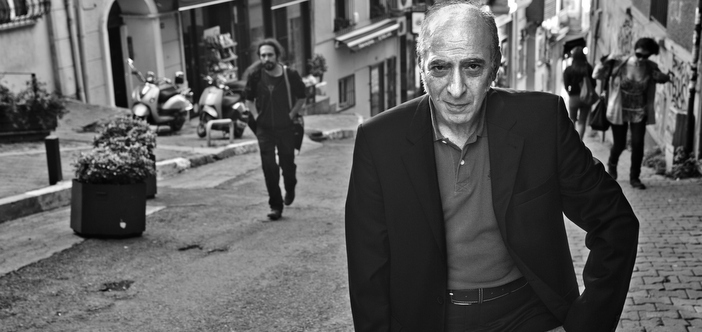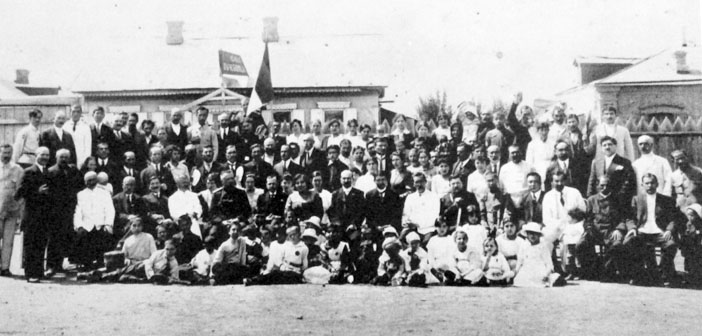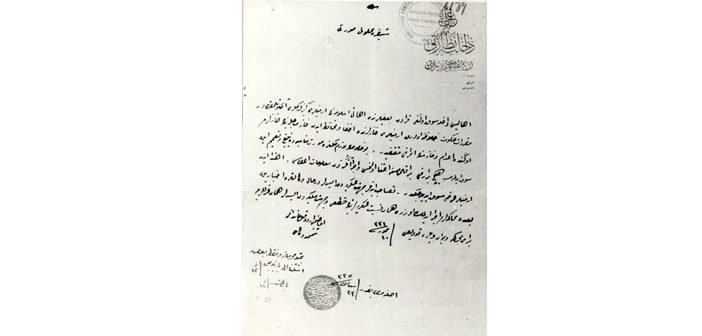Raymond Kévorkian’s work ‘The Armenian Genocide’, a masterpiece in its field, has been published in Turkish by the İletişim Publishing House. In addition to how the book came about, we spoke to Kévorkian about Turkey’s policies regarding the Genocide.
Last week, we spoke to its translator Ayşen Taşkent Ekmekçi about the translation process and what the book means for society in Turkey. Perhaps the most striking aspects of Kévorkian’s work focusing on the stages of the Genocide from the end of the 19th century until the founding of the Republic of Turkey, are its inclusion of various correspondence and testimonies, and its detailed presentation of the places where the massacres took place, region by region, village by village, and with lists of perpetrators and victims... In addition to how the book came about, we spoke to Kévorkian about Turkey’s policies regarding the Genocide.
Could you please tell us about the writing process of this book? How long did the research and writing period take?
This type of work always extends over a long period. One must first master the subject and sources, and that is not always an easy process. The structure of the book gradually takes shape. In the end, the preparation of this study took place over twenty years. I started with a review of the demographic situation of Ottoman Armenians and their presence across the landmass of the Ottoman Empire. That resulted in a work that was also published in Turkish three years ago (with Paul Paboudjian, ‘1915 Öncesinde Osmanlı İmparatorluğu’nda Ermeniler’ [Armenians in the Ottoman Empire on the Eve of 1915], Aras Publishing House). Unknown aspects of the Genocide were also revealed, such as the “second phase” of the Genocide, i.e., the slow death of the deportees in concentration camps in Syria and Mesopotamia. However, I decided to write this book when I was finally able to access the exceptionally rich archives of the Armenian Patriarchate of Istanbul (preserved in the Patriarchate of Jerusalem). The analysis of these documents one by one took two years and the writing itself took another two years.
What was your major motivation in writing such a comprehensive book?
It was clear that the genocidal process had never been seriously studied. My first intention was, on the basis of previous studies on the Armenian presence in Anatolia, to make available to the public, and particularly people originating in or live there now, a tool to help them understand what happened in 1915. That was why I published a region-by-region geography of the Genocide. Such a micro-history was necessary to conduct this work. But isolating the event was clearly out of the question. I considered it important and necessary to place the events in the Ottoman context. It was necessary to find a balance in the examination of the plight of victims and the intention of the perpetrators. In addition to all types of sources we have, it was also essential to refer to the testimonies of survivors, by passing them through the sieve of historical criticism.
What was the reaction in France when the work was first published in 2006?
The public, including second and third generation Armenians, showed interest in the book to understand what had happened to their parents or, in other words, how and why they came to settle in France. The book answers questions many are asking themselves. Historians also showed interested in this study, which was the result of the work of a historian trained in the French historical school. The book may have also helped reduce the last remaining doubts among some historians, especially Turkologists who were inclined to align with the official line, though hardly credible, being more propaganda rather than history.
While you were doing research, what was the most striking aspect for you in terms of differences between the regions the Genocide took place?
The most striking aspect was, no doubt, the impressive level of planning involved in the deportations that took place mainly in just three months, from June to August 1915. Although the procedures related to the organization of the deportation convoys were almost identical, we observe that those departing from Western Anatolia included families with the head of the family present; while in Eastern provinces, which were obviously the priority of the Young Turkish authorities, adult males were executed and women and children were deported without any protection.
Who are the most important actors of the Genocide, and what were the relations between them during the period of the Genocide?
On the side of the perpetrators, the ten members of the Central Committee of the Union and Progress Party were obviously the key decision-makers, planners and implementers of this act of mass violence. These figures, on the one hand, founded the Special Organization (Teşkilat-ı Mahsusa) as the main tool for the destruction of the Armenians and to carry out their dirt business, while on the other hand they succeeded in integrating local administrations into their operations, which would assume responsibility for the planning of deportations.
What is the importance of this book being published in Turkey?
This is not the first book published on Genocide in Turkey. However, its very structure, which aims to not only observe facts from Istanbul, the capital, but also from the provinces, will, I hope, be of interest to people living in provinces affected by the violence, since these events are part of their local history or family. For each region, with the lists prepared by the Armenian Patriarchate of Constantinople, we are able to provide the names of key local figures involved: members of the local Union and Progress organization, administrators of Abandoned Properties (Emval-i Metruke) Commissions, senior officials, gendarmerie officers, police commissioners, Special Organization (Teşkilat-ı Mahsusa) officers, etc., who participated at different levels in the extermination of the Armenian population. I doubt descendants of these figures can remain indifferent to this subject. This study will probably also help students and intellectual readers to form an idea of the conditions that gave rise to contemporary Turkey.
How do you evaluate Turkey’s policy on this issue since the founding of the Republic of Turkey?
It should first be noted that there is an ideological continuity between the Committee of Union and Progress. The Kemalist regime succeeded in ethnically homogenizing Anatolia by using various methods including assassinations, expulsions, deportations and taxation, targeting not only the Armenian survivors of the Genocide, but also Greeks and Assyrians. On the other hand, historians are aware of the fact that the political and military leaders who built modern Turkey were, to varying degrees, involved in the extermination of the Armenians, and gave birth to a singular political culture that continues to influence the leaders of the country. Under these circumstances, the path to recognizing this past of violence on which the Republic was founded, is to question the foundations of the new nation desired by the Young Turks, to ask ourselves questions about the actions of our grandparents; or in brief, as it has been the case for the Kurds for decades, to challenge the modus operandi of the political machine that continues to stigmatize and exclude all groups that do not fall within its mould of imposed identity.
For all these reasons, I do not believe in a rapid transformation of State policy in Turkey. Perhaps change will come from civil society, which is, in many respects, itself a victim of the State ideology.
‘Official denial continues, albeit in a slightly more diplomatic manner’
2007, the year of the assassination of Hrant Dink, is a milestone for Armenians in Turkey. What is your view of the period since?
Hrant Dink had reflected long and hard on the way out of the deadly trap of the widespread stigmatization of a specific community. His words, as we all know very well, sometimes provoked quite strong reactions in the Armenian community, but they have undeniably contributed to the maturation of the concept of dialogue - the term reconciliation seems for now unwelcome. His murder and reactions to it have certainly silenced the most radical circles and motivated many friends to engage more strongly in the struggle for memory, for a reformation of the ideology that still deeply permeates Turkey and its State apparatus. From this, a positive dialogue was born among some segments of Armenian and Turkish civil societies. Obviously, a huge amount of work remains to be done to inform the public and help develop a critical viewpoint, to convince the public that this path leads to a democratic future for Turkey.
How do you evaluate the State’s policy on the Armenian Genocide from 2006 to the present day?
Since Turkey entered into a negotiation process with the European Union, it is undeniable that the recognition of the Armenian Genocide has become, even if it is not explicitly written in any document, an essential political condition for the possible integration of Turkey into the EU. The authorities know that very well and have taken some initiatives to create a better image for the country. These include the restoration of Akhtamar, whose name has been Turkified, and its church covered with a huge Turkish flag; and the proposal to create a commission of historians, or rather propagandists who are expected to discuss a topic they have no advanced knowledge of. Both are desperate attempts to conceal the desire to sustain the policy of denial in a slightly more diplomatic manner. However, it is probable that some Turkish authorities are already considering the next concession to make. Any backwards step the State will take will be in direct proportion to the level of the pressure that will come from civil society in Turkey, and also from the outside.
What are the differences and similarities of government Policy between 1915 and today in view of the current facts in the Middle East?
As I noted earlier, there is continuity in the ideological apparatus of the State. Violent practices, the lack of political dialogue, a stubborn refusal to accept the difference of those who possess an identity other than the official one, complicate the solution of an issue like the Kurdish Question. We have now observed for months the ambiguous position of the Turkish authorities with regard to ISIS. The main reason for that is, at least for observers who know the area, that for Turkey, the Kurdish Question is more of a priority than the threats posed by ISIS for the entire Middle East. We always come back to this ideology of exclusion that has existed since 1915; this dangerous nationalism barely concealed by effective diplomacy.






